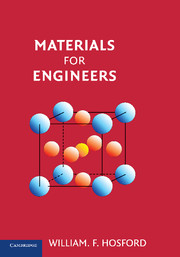Book contents
- Frontmatter
- Contents
- Preface
- 1 Introduction
- 2 Phases
- 3 Diffusion
- 4 Mechanical Behavior
- 5 Mechanical Failure
- 6 Annealing
- 7 Iron and Steel
- 8 Nonferrous Metals
- 9 Casting and Welding
- 10 Solid Shaping
- 11 Polymers
- 12 Polymer Processing
- 13 Glasses
- 14 Crystalline Ceramics
- 15 Powder Processing
- 16 Pottery and Concrete
- 17 Composites
- 18 Carbon
- 19 Fibers, Foams, and Porous Materials
- 20 Electrical Properties
- 21 Optical and Thermal Properties
- 22 Magnetic Materials
- 23 Corrosion
- 24 Modern Manufacturing Techniques, Surface Treatments, and Recycling
- APPENDIX 1 Wood
- APPENDIX 2 Miller Indices for Planes and Directions
- APPENDIX 3 X-ray Diffraction
- APPENDIX 4 Surfaces
- APPENDIX 5 Dislocations
- APPENDIX 6 Avrami Kinetics
- APPENDIX 7 Organic Chemistry
- APPENDIX 8 Average Molecular Weight
- APPENDIX 9 Bond Geometry in Compounds
- APPENDIX 10 Weibull Analysis
- Index
- Conversions
15 - Powder Processing
Published online by Cambridge University Press: 05 June 2012
- Frontmatter
- Contents
- Preface
- 1 Introduction
- 2 Phases
- 3 Diffusion
- 4 Mechanical Behavior
- 5 Mechanical Failure
- 6 Annealing
- 7 Iron and Steel
- 8 Nonferrous Metals
- 9 Casting and Welding
- 10 Solid Shaping
- 11 Polymers
- 12 Polymer Processing
- 13 Glasses
- 14 Crystalline Ceramics
- 15 Powder Processing
- 16 Pottery and Concrete
- 17 Composites
- 18 Carbon
- 19 Fibers, Foams, and Porous Materials
- 20 Electrical Properties
- 21 Optical and Thermal Properties
- 22 Magnetic Materials
- 23 Corrosion
- 24 Modern Manufacturing Techniques, Surface Treatments, and Recycling
- APPENDIX 1 Wood
- APPENDIX 2 Miller Indices for Planes and Directions
- APPENDIX 3 X-ray Diffraction
- APPENDIX 4 Surfaces
- APPENDIX 5 Dislocations
- APPENDIX 6 Avrami Kinetics
- APPENDIX 7 Organic Chemistry
- APPENDIX 8 Average Molecular Weight
- APPENDIX 9 Bond Geometry in Compounds
- APPENDIX 10 Weibull Analysis
- Index
- Conversions
Summary
Many products are made by pressing and sintering powders. Most ceramics are consolidated by sintering. These include clay products as well as refractory oxides. These ceramics cannot be fabricated by melting and freezing. Sintering is also used to produce parts of metals that are difficult to melt. Examples include carbide tools and tungsten for lamp filaments. Mixed powders are sintered to make composites that are not otherwise possible such as friction materials for brakes and clutches. Porous parts for filters or oil-less bearings are made by incomplete sintering. Teflon cannot be melted without decomposing so it is also processed as a powder. Pharmaceutical pills are made from powder. Powder processing is a simple and cheap way of fabricating large numbers of parts.
Powder Compaction
Figure 15.1 illustrates schematically how a part is pressed from powder. The process is highly automated with many parts being pressed per second.
There are limitations on the shape of the die. The shape of the die must be prismatic so the compact can be ejected. The ratio of height to diameter must not be too great. Otherwise friction on the sidewalls of the die will not allow sufficient compaction pressure in the center, as illustrated in Figure 15.2. The loss of compacted density is greater as the ratio of height to diameter increases.
Sintering
Sintering pressed powders at elevated temperature bonds the small powder particles together without melting them. The driving force for sintering is the reduction in surface area and the associated energy.
- Type
- Chapter
- Information
- Materials for Engineers , pp. 151 - 159Publisher: Cambridge University PressPrint publication year: 2008



